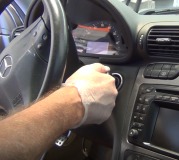My mistake on the crank sensor. You are right that this one does not need to have the air gap set.
One thing to watch out for is the fuel pump runs for one second to insure pressure is up for starting. That verifies the pump is working, but it needs to resume running when the engine is rotating. If it does not, the pressure may drop, but most of the time the cause for it to not resume running also causes no spark.
If fuel pressure drops to 0 psi as soon as you stop cranking the engine, suspect a cut o-ring on the fuel-side nipple on the fuel pressure regulator, even if the regulator was never removed. I ran into two of these, one on a brand new mid 1990's model that had just been delivered to the dealership, and one on a customer's car that had never been serviced for the regulator. Most of the time that will just cause a very long crank time, but if it is bad enough, pressure won't be able to build up high enough.
Try unplugging the MAP sensor's electrical connector, then see if the engine runs any better. Often a clue to a failing sensor is the engine will continue to run as long as you're moving the accelerator pedal. Direction, position, and rate of change do not matter; it just has to be not standing still.
I know this sounds wrong, but you might try a different ignition coil. I battled an intermittent stalling problem for a year and a half on my '88 Grand Caravan that acted exactly like a bad accelerator pump on a carbureted engine. It would die out at anything over about half throttle, but only on hot days, and when it did totally stall, by the time I jumped out and got under the hood, I had spark, and the engine would start right back up. It wasn't until it finally failed completely that I found no spark, caused by the coil.
If you can connect a scanner, verify during cranking that signals are "present" for the cam and crank sensors. If you see the cam signal drop out repeatedly, you might suspect worn distributor shaft bushings. This does not really match your symptoms but if the shaft moves enough, the air gap will be too big, and no signal will be generated. Some engines require cranking for multiple revolutions before the Engine Computer turns on the injectors and ignition coil. If the cam signal keeps dropping out, going to wide-open-throttle can initiate a back-up fuel strategy to allow signal measurements to be taken.
Next, watch the MAP sensor's voltage readings. When you turn the ignition switch on, it takes a barometric pressure reading, and should read around 4.2 to 4.5 volts. The voltage should drop as vacuum increases. Expect to see around 1.2 volts with a properly-running engine. There should be a noticeable drop from 4.2 volts during cranking. Chrysler is the only manufacturer that never needed a mass air flow sensor to make their engines run right. A decrease in vacuum correlates with an increase in load, and the need for more fuel.
Try spraying in a little starting fluid. If the engine fires up, then dies within a few seconds, we'll know it is a fuel problem.
Do you know how to check for diagnostic fault codes yourself without a scanner? You likely will not get codes to set for the cam and crank sensors just from cranking the engine, but you will for any of a number of MAP sensor problems. Cam and crank sensor codes will not turn on the Check Engine light. That light only turns on when the fault code relates to something that could adversely affect emissions. A non-running engine cannot pollute, therefore, no Check Engine light if a code is set for one of those sensors.
Saturday, April 8th, 2017 AT 9:47 PM




